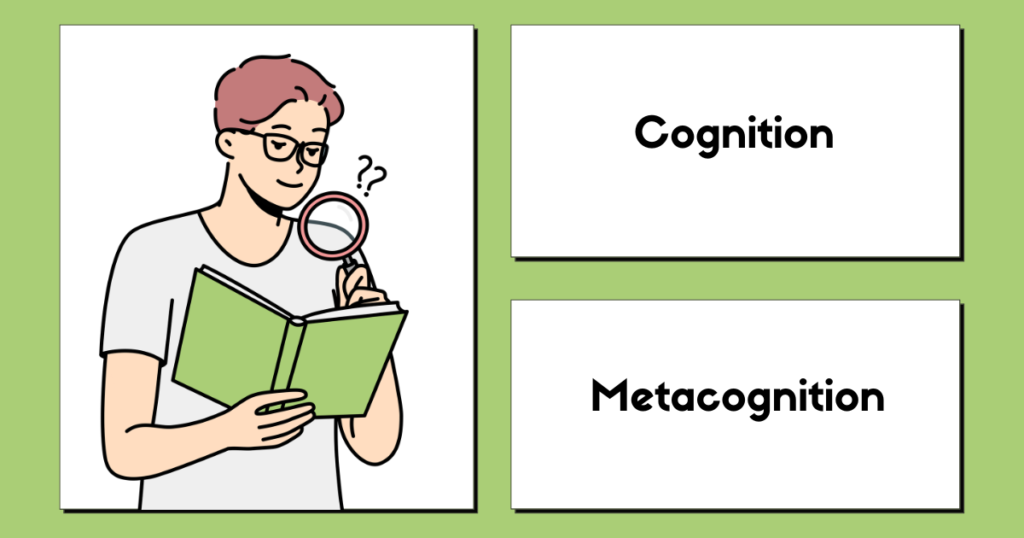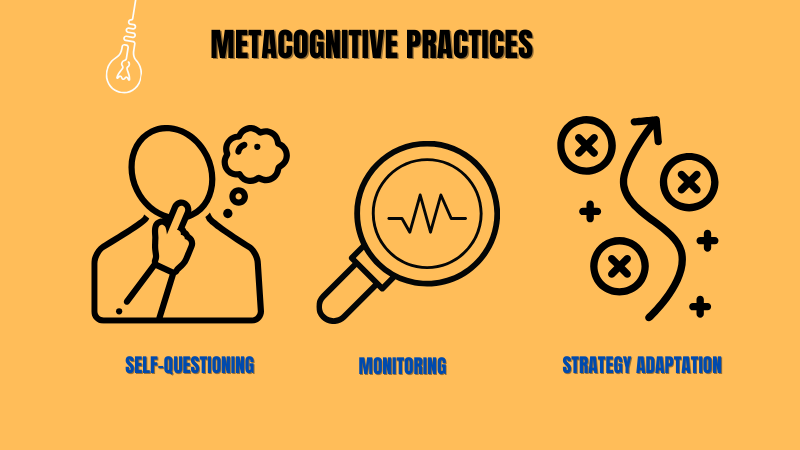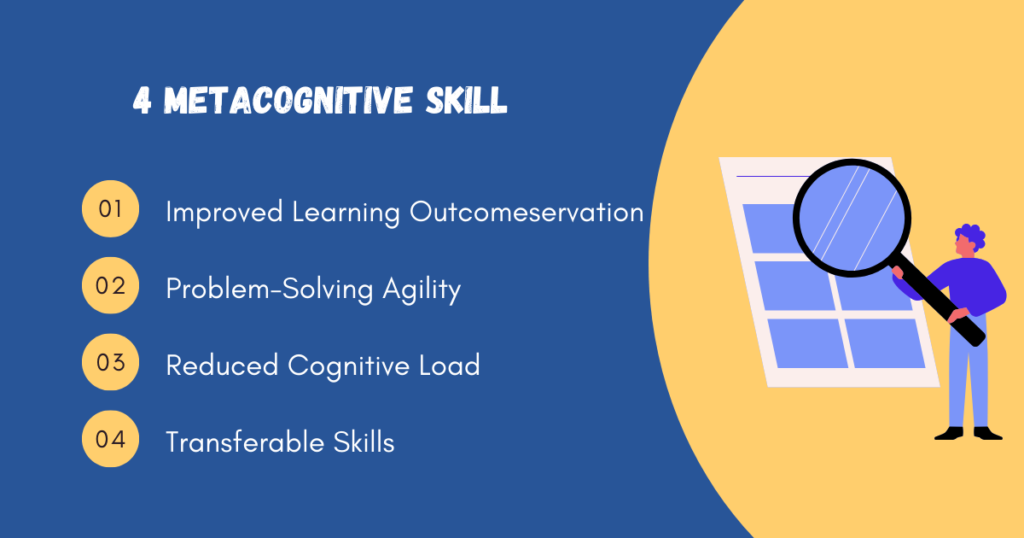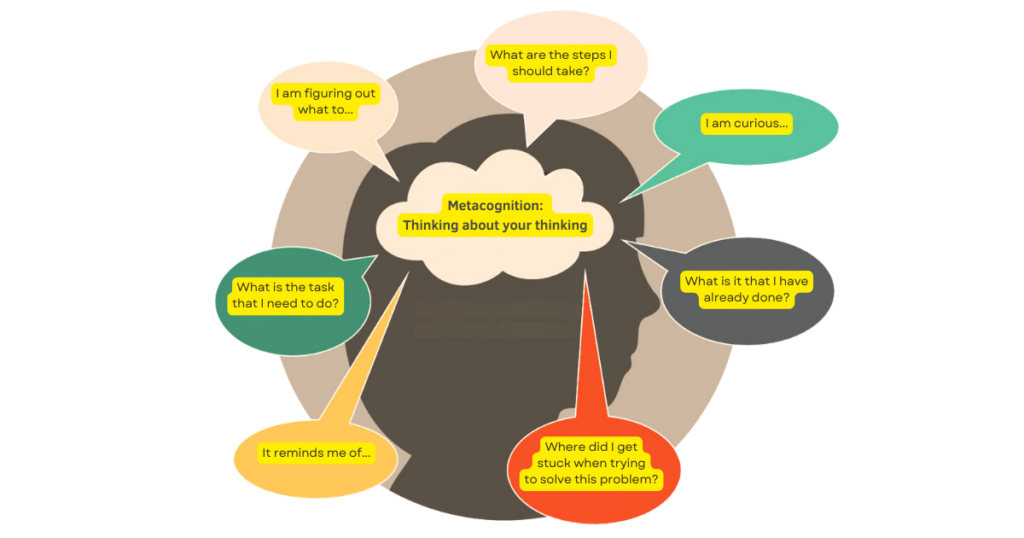Have you ever struggled to learn something new, feeling stuck and confused despite putting in hours of effort? You might have reread chapters countless times, diligently completed practice problems, or even stayed up late cramming information, yet that elusive understanding remained just out of reach.

In this article, we’ll delve into a powerful tool that can break this cycle of passive learning: metacognition in teaching. By understanding what metacognition is in teaching, you’ll uncover the key to empowering learners to take control of their educational journey. So, what is metacognition in teaching, and how does it hold the potential to revolutionize the way we learn? Let’s explore.
Metacognition in teaching is the art of thinking about your thinking. It’s that inner voice guiding you through the learning process, helping you plan your approach, monitor your understanding, and evaluate your progress.
Metacognition refers to the process by which learners actively engage with their own thinking and learning strategies. It involves being aware of one’s cognitive processes, monitoring progress, and evaluating outcomes.
Imagine having a personal learning coach residing within you, constantly analyzing your strengths and weaknesses, adapting your tactics, and celebrating your successes. That’s the incredible power of metacognition in teaching.
This article serves as your guide to unlocking this superpower. We’ll demystify the concept, explore its key components, and delve into how teachers can utilize this magic in their classrooms to cultivate self-aware, empowered learners.
What is The Difference Between Cognition and Metacognition?

Cognition and metacognition are related concepts, but they have distinct differences:
- Cognition:
- Definition: Cognition refers to the mental processes involved in acquiring, processing, storing, and using information. It encompasses a wide range of activities, including perception, attention, memory, language, and problem-solving.
- Function: Essentially, cognition is how our brain processes information from the environment and makes sense of it.
- Examples: When we read, work through math problems, or identify faces, we are actively involved in cognitive processes.
- Metacognition:
- Definition: Metacognition, on the other hand, refers to the awareness and understanding of one’s own cognitive processes. It involves:
- Reflecting on one’s thinking.
- Monitoring and regulating cognitive activities.
- Making strategic decisions about how to approach tasks.
- Importance: Metacognition is essential for effective learning and problem-solving because it allows individuals to become more aware of their own thinking processes and make intentional decisions about their approach.
- Skills: Metacognitive skills encompass abilities such as planning, monitoring progress, self-evaluation, and self-regulation.
- Definition: Metacognition, on the other hand, refers to the awareness and understanding of one’s own cognitive processes. It involves:
In summary, cognition is the foundation upon which metacognition is built. While cognition focuses on mental processes, metacognition enables us to think about how we think and optimize
Components of Metacognition
Metacognition, the art of “thinking about your thinking,” isn’t just a fancy educational term; it’s the key to unlocking your full learning potential. Imagine stepping into a vast library, equipped with a map and tools to navigate its treasure trove of knowledge. Metacognition empowers you to become that navigator, guiding your learning journey with self-awareness, strategic planning, and insightful evaluation.
Let’s delve into the key components of metacognition, unveiling the secrets to becoming a self-directed learning master: the knowledge component and the regulatory component.
1. Metacognitive Knowledge: Self-Awareness as a Learning Compass
Know thyself, know thy learning journey. This first component revolves around understanding yourself as a learner. It’s about building self-awareness and acknowledging your strengths, weaknesses, and preferences. Just like choosing the right tool for the job, understanding your individual learning style (visual, auditory, kinesthetic) helps you select the most effective strategies for each task.
Are you an information sponge who thrives on detailed notes? Or do you learn best through visual aids and hands-on activities? Recognizing your preferences equips you to choose the path that leads to deeper understanding.
But it doesn’t stop there. Metacognitive knowledge also encompasses understanding different learning strategies and their strengths. Flashcards might work wonders for memorizing vocabulary, while mind maps excel at connecting complex concepts. Knowing the tool kit available empowers you to choose the right strategy for the specific learning challenge you’re facing.
2. Metacognitive Regulation: Charting Your Learning Course
Once you know your strengths and have the tools at your disposal, it’s time to take control! Metacognitive regulation is all about actively charting your learning course.

Think of metacognition in teaching as a three-pronged compass guiding your learning journey:
- 1. Planning: This involves setting clear goals, choosing appropriate strategies based on the task and your learning style, and anticipating potential challenges. Imagine preparing for a hike. You wouldn’t blindly venture into the wilderness without packing appropriate gear, planning your route, and anticipating weather changes. Similarly, metacognition encourages students to become strategic learners, crafting a personalized roadmap to reach their learning destinations.
- 2. Monitoring: This is the act of checking your understanding throughout the learning process. Are you grasping the concepts? Is your chosen strategy effective? Do you need to adjust your approach or seek clarification? Think of it like navigating a hike—constantly checking your map, observing landmarks, and adapting based on the terrain. Metacognition empowers students to become active participants, not passive listeners, constantly gauging their comprehension and adjusting their learning course as needed.
- 3. Evaluating: This final stage involves reflecting on your learning experience, assessing your progress, and identifying areas for improvement. Just like reflecting on your hike, and analyzing what worked well and what could be done better, metacognition encourages students to critically evaluate their learning journey. Did the chosen strategy yield results? Are there alternative approaches to explore? This self-reflection fosters a growth mindset, empowering students to continuously refine their learning strategies and become self-assured, adaptable learners.
Remember, metacognition in teaching isn’t just about acquiring knowledge; it’s about fostering the crucial skills to learn effectively, adapt efficiently, and become a lifelong learner. It’s about empowering students to take ownership of their learning journey, transforming them from passive recipients of information into active architects of their understanding.
Why Metacognition Matters: What Is Metacognition in Teaching
Metacognition, often referred to as “thinking about thinking,” plays a pivotal role in our ability to learn, problem-solve, and adapt. It’s the inner dialogue that guides our cognitive processes, allowing us to monitor and regulate our thoughts, strategies, and understanding. In the context of education, metacognition is a powerful tool that can significantly impact student success.
How Metacognition Influences Exam Performance
Let’s delve into a typical student scenario. Imagine a dedicated student, Alex, preparing for a challenging exam. Alex attends classes, takes thorough notes, and diligently completes practice problems. However, when the exam day arrives, Alex’s performance falls short of expectations. What went wrong?

The answer lies in metacognition. Alex focused on surface-level learning—memorizing formulas and solving problems mechanically—without truly understanding the underlying concepts. Alex lacked metacognitive awareness—the ability to reflect on one’s learning process, identify gaps, and adjust strategies accordingly.
Now, consider another student, Maya. Maya approaches the same exam differently. She engages in metacognitive practices:
- Self-Questioning: Maya asks herself, “Do I truly grasp the fundamental principles behind these equations?” She digs deeper, seeking connections between concepts.
- Monitoring: During practice sessions, Maya monitors her comprehension. If she struggles with a problem, she pauses, reflects, and identifies the specific challenge.
- Strategy Adaptation: When faced with a complex problem, Maya doesn’t panic. Instead, she adjusts her approach. If one method fails, she explores alternatives.
The result? Maya performs exceptionally well on the same calculus exam. Her metacognitive skills allowed her to navigate the material effectively, retain knowledge, and apply it flexibly.
The Need for Explicit Metacognitive Skill Development in Education

Metacognition isn’t innate; it’s a skill that can be cultivated. Unfortunately, many educational systems prioritize content over process. Students receive information but often lack guidance on how to learn effectively. Here’s why explicit metacognitive skill development matters:
- Improved Learning Outcomes: When students understand their learning process, they become active participants. They engage in deeper learning, connect ideas, and retain knowledge beyond rote memorization.
- Problem-Solving Agility: Metacognition equips students with problem-solving tools. They learn to assess their understanding, identify misconceptions, and adjust strategies. These skills extend beyond exams—they’re essential for lifelong learning.
- Reduced Cognitive Load: Metacognition streamlines learning. Students learn to allocate mental resources efficiently, focusing on what truly matters. They become efficient learners.
- Transferable Skills: Metacognitive practices aren’t confined to specific subjects. They transfer across disciplines, benefiting students in science, literature, art, and beyond.
Metacognition isn’t an abstract concept; it’s a practical skill that transforms learning experiences. As educators, we must prioritize metacognitive development alongside content delivery. Let’s empower students like Maya—students who not only know what to learn but also how to learn. By doing so, we foster critical thinkers, problem-solvers, and lifelong learners.
Read Also: Transformative Pedagogical Approaches: The Future of Education
Power of Metacognition in Teaching: The Magic for Students and Teachers
Imagine a classroom buzzing not just with activity but with intentional learning. Students aren’t passively consuming information but actively engaging, strategizing, and reflecting on their progress. This, my friends, is the transformative power of metacognition in teaching in action.
Cultivating metacognitive skills in students isn’t just an educational fad; it’s an investment in their future. Here’s why:
- Empowered Learners: With metacognition, students become active participants, not passive recipients. They learn to set goals, plan their learning journey, and monitor their progress, fostering a sense of ownership and responsibility. Imagine the shift: instead of waiting for the teacher to spoon-feed them information, students become strategic learners, capable of adapting their approaches and seeking help when needed. This newfound agency fuels motivation, confidence, and a lifelong love of learning.
- Deeper Understanding: True learning goes beyond rote memorization. Metacognition encourages students to go beyond the “what” and delve into the “why” and “how” of knowledge. They analyze, synthesize, and evaluate information, building deeper connections and constructing meaningful understanding. Think of it like building a house. With metacognition, students aren’t just assembling bricks; they’re architects, understanding the structure and purpose of their learning edifice.
- Improved Efficiency: Imagine spending hours studying only to feel like you’re treading water. Metacognition helps students identify effective learning strategies. They learn to allocate their time wisely, choose the right tools, and adjust their approach based on their strengths and weaknesses. This optimization leads to improved learning outcomes and reduced frustration, freeing up valuable time and mental energy for exploration and deeper engagement.
- Enhanced Self-Awareness: Metacognition fosters self-reflection, encouraging students to analyze their learning styles, preferences, and areas for improvement. This introspective awareness empowers them to make informed choices about their learning journey, developing a growth mindset and a belief in their own potential. It’s like having a personal learning coach whisper wise advice and guide them toward becoming truly self-directed learners.
But how do we, as teachers, unlock this magic for our students? Here’s where the “how” of metacognition in teaching comes alive:
- Explicit Instruction: Don’t assume students will magically develop metacognitive skills. Make these skills visible! Dedicate time to explaining and modeling metacognitive strategies, encouraging discussions and reflections. Help students understand the why behind these strategies, connecting them to real-world learning scenarios.
- Inquiry-Based Learning: Move away from teacher-centered lectures and embrace inquiry-based activities. Encourage students to ask questions, formulate hypotheses, and investigate solutions. This hands-on approach naturally fosters metacognitive skills as students plan, monitor, and evaluate their learning throughout the process.
- Metacognitive Prompts: Integrate thought-provoking questions into your lessons. Prompt students to reflect on their understanding, ask them to explain their thought processes, and encourage them to evaluate the effectiveness of their chosen strategies. These regular metacognitive moments become stepping stones for self-awareness and strategic learning.
- Self-Assessment Tools: Empower students to track their progress and identify areas for improvement. Utilize learning logs, journals, and self-assessment rubrics to encourage reflection and goal setting. By taking ownership of their learning journey, students become active collaborators in their own academic success.
- Collaborative Learning: Encourage students to work together, sharing their learning strategies and offering constructive feedback. This collaborative environment allows students to learn from each other’s metacognitive approaches, fostering a community of support and shared growth.
Remember, metacognition in teaching is not a one-time lesson; it’s a continuous journey. By integrating these strategies into your classroom and fostering a culture of metacognitive reflection, you’ll witness the magic unfold: students who are engaged, empowered, and self-directed learners, ready to conquer any academic challenge!
What are Some Examples of Metacognitive Strategies?
Ever feel like you’re studying hard but not getting anywhere? You’re not alone! Sometimes, just hitting the books isn’t enough. Here’s where metacognitive skills come in. Think of them as superpowers for learning; they help you understand how you learn best. Let’s explore some examples:

- Self-Questioning:
- Pause during a task to consciously check your actions.
- Ask important questions like:
- Is this the best way to carry out this task?
- Did I miss something? Maybe I should check again.
- How could I do better next time?
- Am I looking at this task the right way?
- Good students interrogate their actions both during task completion and upon its completion.
- Meditation:
- Clear your mind and reach a calm, focused state.
- Enhance self-awareness and inner speech.
- Meditation is increasingly used in schools to help students attain heightened self-awareness.
- Reflection:
- Pause to think about a task.
- Reflect on your thought processes and ways to improve.
- Follow reflective cycles:
- Plan the task.
- Attempt the task.
- Evaluate how you did.
- Identify areas for improvement.
- Plan the next task, focusing on weaknesses.
- Repeat the process.
- Competent reflection can occur even while performing a task (known as reflection in action).
- Awareness of Strengths and Weaknesses:
- Recognize your own strengths and weaknesses.
- Genuine assessment leads to self-improvement.
- Thinking Aloud:
- Verbalize your thought process while solving problems.
- It helps you monitor and adjust your thinking strategies.
- Active Listening:
- Engage fully in listening to others.
- Reflect on what you’ve heard and how it connects to your existing knowledge.
- Using Mnemonic Aids:
- Employ memory techniques (mnemonics) to enhance recall.
- Examples include acronyms, visualization, and memory palaces.
These are just a few examples! The key is to experiment and find what works best for YOU. With a little metacognitive magic, you can unlock your full learning potential and become a true learning master!
Remember, metacognition empowers learners to take charge of their learning journey. By incorporating these strategies into teaching practices, educators can cultivate lifelong learning skills and enhance learning outcomes effectively.
Conclusion
So, what is metacognition in teaching? It’s not just a fancy educational term—it’s a revolutionary approach to empowering students to become self-directed, confident learners. By equipping them with the metacognitive skills to think about their thinking, we unlock a world of possibilities in the classroom.
We’ve explored the key components of metacognition in teaching:
- Metacognitive knowledge: understanding oneself as a learner and different learning strategies.
- Metacognitive regulation: planning, monitoring, and evaluating the learning process.
- Metacognitive experience: the emotions, thoughts, and awareness you have while learning.
By integrating these components into your teaching, you foster a culture of metacognitive thinking. Students become active participants, no longer passively receiving information but actively constructing their understanding. They learn to ask questions, set goals, monitor their progress, and adapt their strategies based on their needs.
The benefits of what is metacognition in teaching are undeniable:
- Deeper learning: Students move beyond rote memorization to grasp concepts critically and connect them to real-world applications.
- Improved problem-solving: They develop the skills to analyze challenges, identify solutions, and adapt to new situations.
- Enhanced self-motivation and confidence: By understanding their learning process, students take ownership of their education and become more engaged learners.
- Lifelong learning skills: They cultivate the tools and mindset to continue learning and exploring throughout their lives.
Remember, metacognition in teaching is not a one-time lesson; it’s a journey of continuous discovery. Embrace it as a core principle in your teaching philosophy, experiment with different strategies, and encourage your students to explore their own metacognitive superpowers.
Together, let’s transform classrooms into vibrant hubs of self-directed learning, fueled by the magic of what is metacognition in teaching!
Ready to explore further? Delve into specific metacognitive strategies, share your experiences with other educators, and embark on this transformative journey with us! Remember, the power of metacognition in teaching lies in its potential to unlock the potential of every learner. Start today and witness the magic unfold!

Leave a Reply
You must be logged in to post a comment.